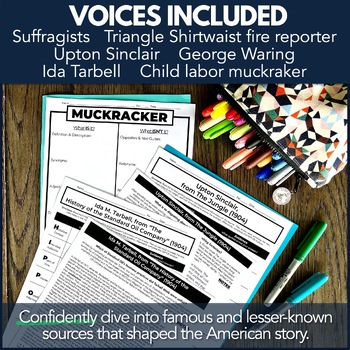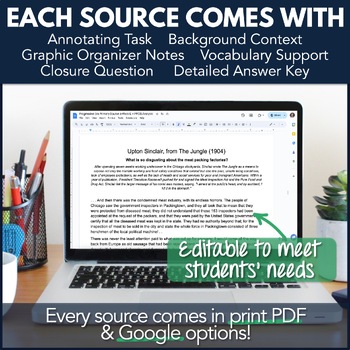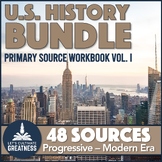Progressive Era Primary Sources Activity Analysis Worksheets 6-Pack
- Zip
- Google Apps™

Also included in
- Strengthen your on-level U.S. History or AP US History units with 48 1-page-or-less, high-interest primary sources from 1900s modern American History:Turn of the Century - Progressive Era, Roaring 1920sHard Times - Great Depression, WWIIMid-Century - Cold War, Civil Rights MovementLate 1900s - VietnPrice $27.50Original Price $36.00Save $8.50
Description
Challenge your students to feel empowered to be their own agents of change by exploring the arguments and causes of Progressive Era activists in this engaging primary source collection that questions, exposes, and creates change.
This 6-pack also comes in Google Slide format for a paperless option!
Featured voices in this collection of compelling arguments:
- NAWSA & women suffragists
- Triangle Shirtwaist Factory fire reporter
- Upton Sinclair
- George Waring
- Ida Tarbell
- Child labor muckraker
The effective HIPPOS framework directly targets Common Core critical thinking skills:
- Historical Context
- Intended Audience
- Point of View
- Purpose
- Outside Information
- So, what?
************************************
Greatness is learning the power that articulate and persuasive writing holds in creating change.
The Progressive Era of the turn of the century produced many improvements to social, political, and economic problems thanks to the hard work, dedication, and persuasive words of many activists.
Whether arguing for the right to vote, the eradication of child labor, or the need for urban sanitation programs, words helped win the fight.
Cut through the boring textbook and head straight to the compelling sources that make this era one of great empowerment for the average men and women who saw an injustice, shared their thoughts, and created lasting change, challenging your students to wonder, “How can my words change the world?”
Included in this kit are:
- Detailed lesson plans, with strategies for different reading levels
- 1-page definition sheet for the concept “muckraker”
- 1-page HIPPOS handout and BONUS skill sheet, Annotating a Text
- 6 2-page student worksheets with a short primary source document & graphic organizer sheet
- Answer keys, one for each document
- EDITABLE Word Doc with all 6 sources and a generic graphic organizer sheet included to tailor to your classroom needs
- Google Slides version of all student sheets
Teaching Tips
- If used in-class, plan for up to 60 minutes to deeply introduce, read, annotate, analyze, and discuss each document.
- These documents also can be easily assigned as part of a jigsaw or gallery walk activity, as homework, or to keep on hand for emergency sub plans!
- Depending on the included scaffolds you use, these documents can be accessed by a wide range of reading levels
***********************************
Bundle and save!
1600s - 1800s 48-Pack Bundle: get 8 HIPPOS Packs, from Colonial Era to Gilded Age
1900s 48-Pack Bundle: get 8 HIPPOS Packs, from Progressive Era to Modern Era
Or mix and match
Colonial America: analyze the rough start of the English colonists, the enslaved Africans, and the invaded Indians.
Early Nationhood: juxtapose the declared values of democracy with the arguments of its outsiders.
Era of Reform: hear the impassioned voices for change.
Westward Expansion: explore the mania and the mayhem created out West.
The Civil War: contrast the two very different defenses for freedom.
Reconstruction: evaluate the successes of national policy on the individual in post-Civil War America.
Gilded Age Diversity: compare the common dreams of a developing melting pot.
Gilded Age Labor: hear the voices of those who felt unheard in this age of wealth.
Roaring 1920s: sense the growing divide between rural, traditional and urban, modern American societies.
Great Depression: explore the changing relationship between president and citizen.
WWII Warfront: explore the difficult decision made by political and military leaders in the fight of their lives.
Cold War: examine the word choices of leaders fighting a war of words.
Civil Rights Movement: analyze the impassioned arguments of those for and against equality.
Vietnam War: weigh the role public opinion should play in complex foreign policy.
Modern Presidents: hear how our leaders struggle to unite the country.
************************************
This listing is for one license for regular, non-commercial classroom use by a single teacher only. Commercial use like online teaching (ex. Outschool) or sharing with other teachers (ex. shared drive, in a Facebook group, in a professional development training) is strictly prohibited.
By purchasing a license to this resource, you have access to all future updates at no cost, available under “My Purchases." Multiple and transferable licenses are available for purchase. PDF files are uneditable, other files have editing abilities, unless otherwise stated. All files are protected under federal copyright laws.
To request a complete terms of use prior to purchase or if you have any questions about this resource, please leave a question below under Product Q&A.






